KNOWN UNIVERSE EPISODE 306: CONSTRUCTION ZONE
Being a professional astronomer and hosting a TV show is awesome. Just like anything though, sometimes it is easy to forget how great it is. But when that happens, all I have to do is watch an episode like this to remind myself. When I was watching it, I just kept saying, “Whoa!” And, “We’re in the future!” This is my favorite episode out of everything we’ve done on KNOWN UNIVERSE, because there’s a real sense of awe and wonder associated with the material we cover this week. You can see it in the sense of glee shown by the hosts. Ostensibly it is about building things in space. But in the process of investigating that we cover all kinds of science fiction technology that is now a reality. STAR WARS, STAR TREK, 2001… it’s happening! First off – my firsthand account of my first filming outing after being selected for the show.
TOO TALL TO BE AN ASTRONAUT?
November, 2010. I’m at NASA’s Johnson Space Center, in the advanced space suit lab, being fitted for a space suit. Surely this is never going to work: at 6’4”, I’ve always thought I was too tall to be an astronaut. The space suit team is skeptical that I’m going to fit. Astronaut Mike Massimino hands me a diaper and says, “If you want the real astronaut experience, you start with the diaper!” “No thanks!” I say, “I don’t plan to be in there that long!”
Mike is one of NASA’s tallest astronauts, at somewhere around 6’2”, so the suit team decides to use his suit settings, and add spacers everywhere they can. To put on the undergarments, I got into what amounts to the strangest dressing room I’ve ever been in: a curtained area in the corner of a room at NASA. On the other side are Mike, four suit designers and technicians, and a four person TV crew recording the process. I start with the official astronaut undergarments provided to me by NASA: blue shorts and t-shirt made out of a jersey-type material, designed to wick away sweat. Then I get into what looks like a supervillain outfit: a mesh silky jumpsuit with tubes running all over it. Large hoses run down my arms, and there are thumb loops to keep the sleeves down. I come out of the curtain feeling like I can shoot fire out of my hands.
It would look too silly to show me coming out of the curtained corner of this crowded room, so we decide that I’ll enter from a doorway. Cameras roll, and Mike explains that next up is the LTA: lower torso assembly: basically, it is just a fancy way of saying space pants. It takes several people to get me into the pants-boots combo, but finally, I’m able to wiggle all the way in and stand. They fit!
Holding up my pants, I walk over to the HUT: hard upper torso. This thing is so heavy that on Earth it has to be mounted on a stand. And sure enough, it is rigid. Looks like a tight fit – I have no idea how I’m going to get into this thing. Mike explains that the trick is to squat down below the HUT, put your arms over your head, and slowly stand into it, while wiggling your arms out the arm holes. But you have to be very careful – if you slip, your arm is trapped in the hole and you can easily dislocate your shoulder. This has happened before. Mike says if he or I feel like it isn’t working we’ll have to call it off – it isn’t worth being injured over.
I start standing, and it is becomes clear that I may well be too large. My shoulders are too broad to fit through the rigid opening without some serious bodily contortions. And then my arms are so long I can’t find an angle that will get them through the holes. I struggle for what seems like many minutes, all the while in a continuous half-squat. My legs are shaking, and I’m sweating profusely. I can’t keep this up much longer. The suit guys are trying to help me, but I sense their skepticism. But with one last push, I’m finally able to squirm, contort, and wriggle my way into standing upright, turning my head to the side to fit it out the narrow neck opening. I’m in! My helpers lock my pants to the HUT. I still have gloves to attach, but vertically, at least, I fit!
My initial relief gives way to several new troubling sensations though. First, I’m burning up, and sweating like crazy. But even worse, I feel like I can hardly breathe – the HUT is rigid, and I’m so crammed in that I can’t even take a full breath. And if that weren’t enough, I have an overwhelming sensation that I’ve never had before – claustrophobia – I am totally cocooned, hot, and suffocating, in hundreds of pounds of gear, and there is no way to quickly get out. In fact, I’m locked in.
I concentrate on staying calm, and find that with shallow breaths I can get enough air. They turn on the cooling system and from my backpack, cool water floods the tubes all over my body. It is amazing! Within seconds, my body comes right back to a normal temperature. They show me that I can adjust the dial on my chest plate to regulate the temperature. Between the chest controls and the air flow that they’ve also switched on, I feel just like Darth Vader! You can’t move your head enough to see the chest controls, so astronauts carry a mirror attached to their arm, and the numbers are written backwards, allowing them to make adjustments.
On go the gloves. They fit too! I can fit into a space suit! Maybe I’m not too tall to be an astronaut after all. The NASA people insist that they leave one glove unlocked, so I won’t suffocate if the air system fails. I’m so tightly crammed in, no air is getting up that arm anyway, but of course I don’t tell them that.
Next up is the snoopy cap, with integrated speakers and microphone. I’m startled to hear a voice over the speaker – it is really wired up, and one of the technicians is talking to me. Now I feel like I’m in an episode of FROM THE EARTH TO THE MOON.
Next up – the helmet. I’ve already heard from Mike that this is one of the most aggravating things about the space suit – you can’t touch your face. The only thing they have is two cubes of foam stuck to the inside of the helmet. To clear your ears from the pressure change you put your nostrils over the cubes and blow. But in a pinch you can also move your head against them to scratch an itch. Mike says, “Any last itches? Blow your nose, cough, spit? Because once we put this on, that’s it.” I give him the final go-ahead, and he lowers and locks the helmet into place. My transformation into Vader is complete!
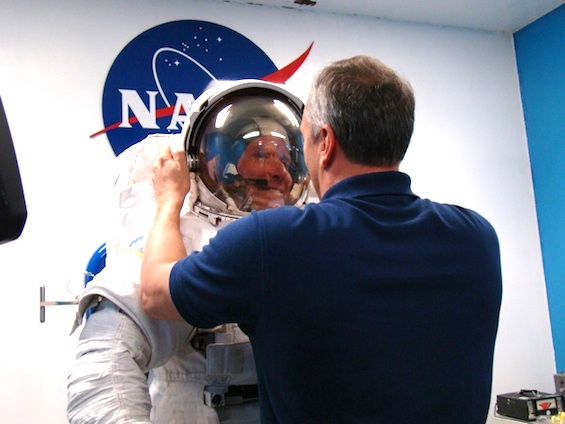
Fortunately there were no mind-controlling eels in the helmet.
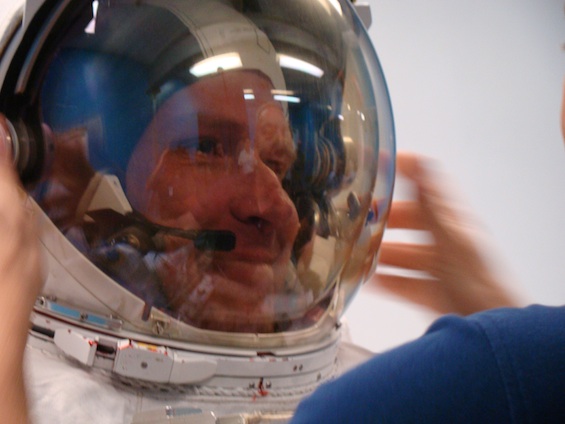
In the helmet, with the mechanical breathing, I can’t hear a thing from the outside world. Good thing I have the snoopy cap so I can get direction from the producer. As directions come crackling in, air and water are flowing, reality of it all sinks in. I’m at NASA, in a friggin’ space suit, and it is all being captured for TV! I’m so excited, I’m about to wet my pants. Maybe I should have taken that diaper after all.

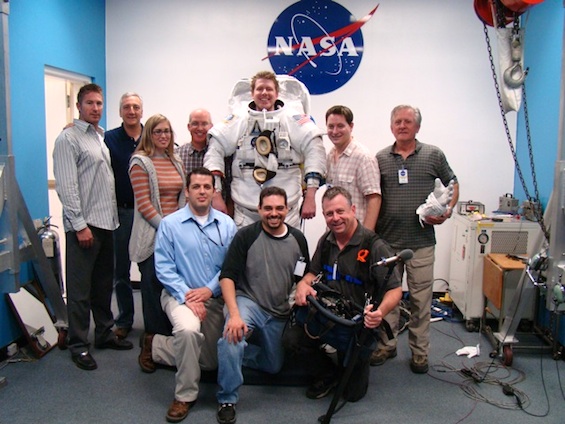
Here’s the video. It starts with Mike showing off some tools and ends with me in the suit.
MIKE AND SIGRID ENTER THE MATRIX
So why were they putting me in a space suit? This episode is 306: CONSTRUCTION ZONE. In it we learn how astronauts build things in space, both today and in the future. It isn’t easy to build in space, partly because you have to do it in a space suit. But weightlessness can add challenges too. To experience this, Sigrid Close and Mike Massimino went to NASA’s virtual reality trainer.
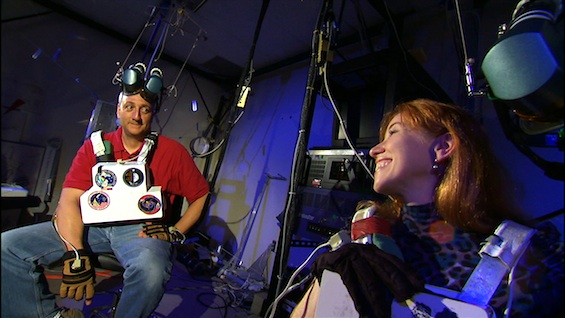
After donning the VR goggles, mike showed Sigrid the ropes. Training for spacewalks with virtual reality – its like we’re in the future! Of course Sigrid knew all about Newton’s Third Law – for every action there is an equal and opposite reaction, but knowing it and experiencing it are very different things!
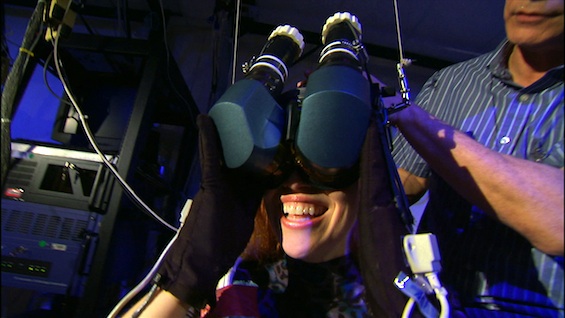
I love how much fun Sigrid is having here. I’m jealous I didn’t get to do this segment!
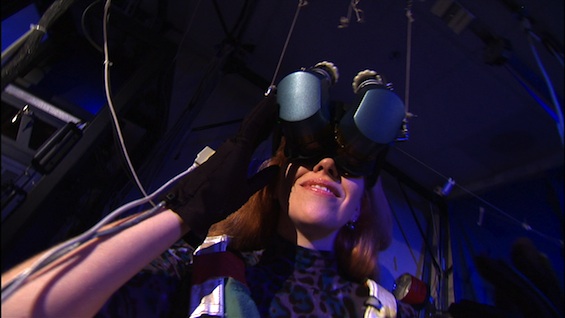
ROBOTS, SERIOUSLY, ROBOTS IN SPACE
But what about tasks that are hard for astronauts to do? For that, NASA has invented Robonaut – a robot to help the astronauts. But this isn’t just some research project. This thing is aboard the space station! Can you believe there is a robot on the space station? The space station has its own Bishop / C3P0 / Commander Data! GM helped develop it. Take that Honda! Americans can make robots too – and we put ours into space! We really are in the future.

Mike is having trouble holding this dumbbell out straight for a few minutes. Not Robonaut though. Hope Mike doesn’t go the way of John Henry.
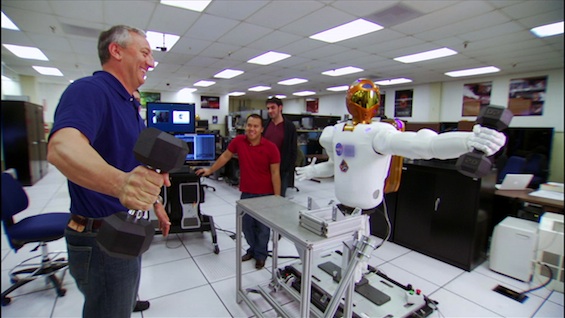
THAT’S NO MOON…
At NASA, they have a full-sized mock-up of the space station. In this episode, Mike takes us on a tour of the station. In contrast to the Space Shuttle, the station is quite huge – it is the length of a football field. I got to run through it when I was at Johnson doing some filming, and it is impressive. Being in it feels like you are in a movie set. I can’t believe there is a real space station orbiting overhead right now with people in it.
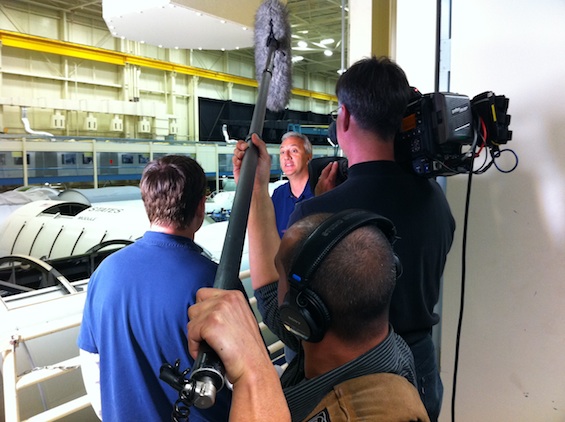
SHIELDS UP
Speaking of the space station, have you ever wondered how they shield it from orbiting space debris? There are pieces of junk orbiting the earth ranging in size from flecks of paint to old rocket stages. And they are orbiting at 18,000 miles per hour – more than 10 times faster than bullets! Even a bb-sized piece of material could spell disaster if it strikes the shuttle or station. To learn how they test and build shields for the space station, I visited NASA White Sands test facility. Out in the middle of the desert they have built what I can only guess is the world’s biggest gun, at least in the somewhat conventional sense. It is 60 feet long and using a combination of technologies can accelerate projectiles up to 18,000 miles per hour. They then put various shielding materials arranged in different configurations in the vacuum test chamber and shoot stuff at it. To do the test, we even had to clear the gun deck and go into a bunker! They even had two keys that you had to turn to fire the gun like in WAR GAMES!
Here I am using a sight to line up the target and the gun.
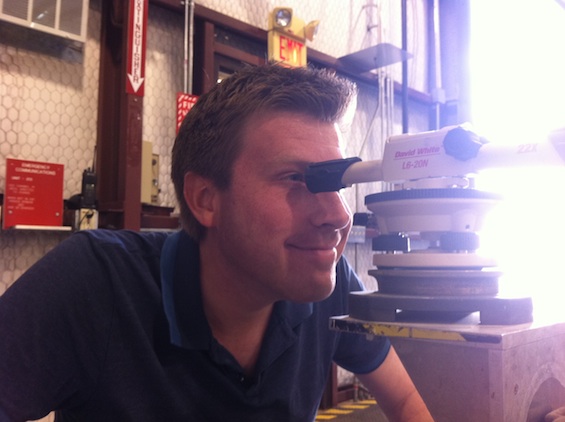
And here I am inspecting the damage after the target has been hit. The test target has four layers – the first two are metal and Kevlar shields, and the third represents the hull of the space station. So the ISS does have shields, just not electromagnetic ones.
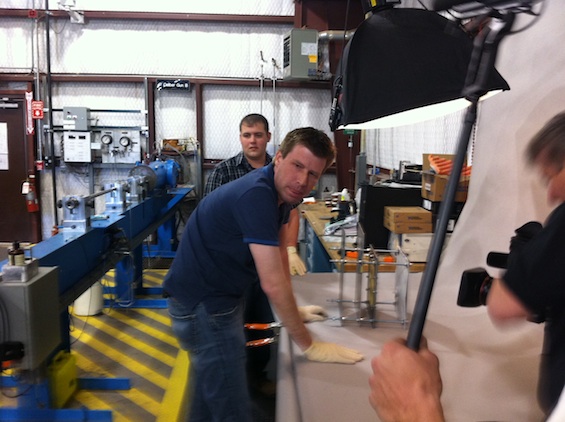
DAVID KAPLAN USES A REPLICATOR!
What happens when you need to make a repair in space, but you don’t have the right tool? It would be helpful to have a replicator, right? In a sense, this technology already exists. There are 3D printers that can make arbitrarily complicated 3D objects in minutes. They can even make them with embedded moving parts! David Kaplan used one to make this:
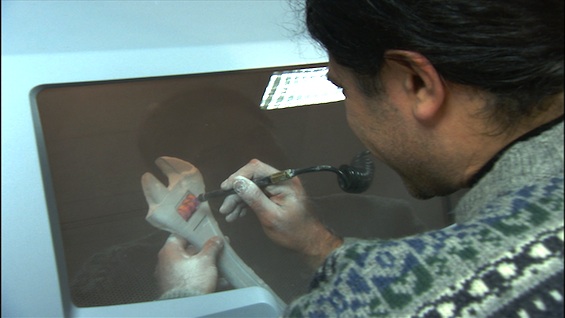
He started off with a box of powder, then reached in and pulled a fully functional wrench with moving parts! He’s dusting some of the residual powder off in the above picture. Now we really, really are in the future! This stuff just blows my mind. I didn’t see this segment until it was folded into the show, and I just kept saying, “Whoa!”
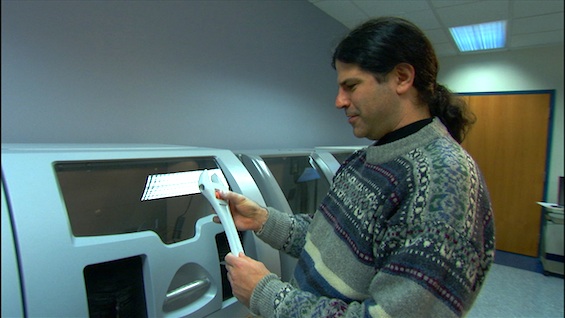
I’M SORRY DAVE, I’M AFRAID I CAN’T DO THAT
For long distance travel in space, we’ll need artificial gravity. One way to do that is to have your space ship accelerate at 9.8 meters per second to match the acceleration due to gravity on Earth.
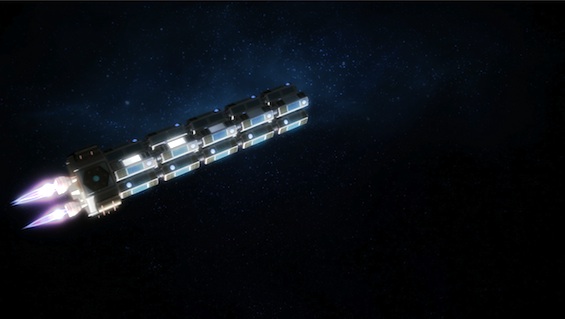
But what happens when you reach your destination? Then you’ll want to make your ship transform and rotate, like in 2001.

How can we achieve this? How about superconducting magnets! David Kaplan shows how superconductors get wacky when it comes to magnetic fields. Using this trick you can even make things levitate. Ok, so landspeeders – we’ve got that technology too!
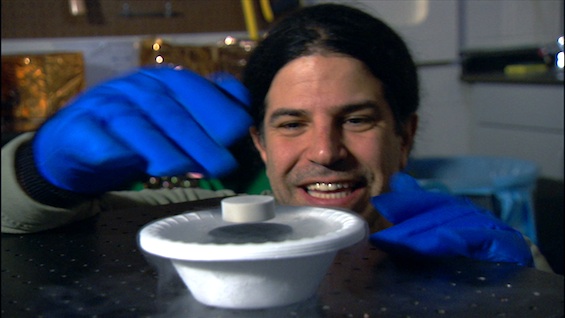
How can that be used to transform a space station? You’ll have to watch the show to find out.
It is really hard to believe that we are showing off space stations, robots, shields, levitation, and replicators! This isn’t speculative hoo-ha, these things are a reality today. This episode, CONSTRUCTION ZONE, premieres at 9 pm Thursday, June 9 on NatGeo.
-Andy Howell aka Copernicus
